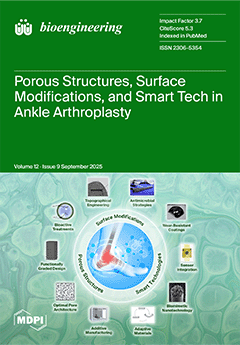This study reports, for the first time, lanthanum oxide (La
2O
3) nanoparticles (NPs) that simultaneously suppress osteosarcoma MG63 cell proliferation and promote normal Vero cell viability, a dual effect not previously documented for La
2O
3 or similar metal
[...] Read more.
This study reports, for the first time, lanthanum oxide (La
2O
3) nanoparticles (NPs) that simultaneously suppress osteosarcoma MG63 cell proliferation and promote normal Vero cell viability, a dual effect not previously documented for La
2O
3 or similar metal oxide NPs. Physico-chemical characterization revealed a unique needle-like morphology, cubic crystallinity, and dispersion stability in DMSO without acidic dispersants, properties that can influence cellular uptake, ROS modulation, and biocompatibility. Comprehensive characterization (fluorescence spectroscopy, particle size/zeta potential, Raman, XRD, TGA, ATR-FTIR, and TEM) confirmed structural stability and surface chemistry relevant to biological interactions.La
2O
3 NPs exhibited broad-spectrum antibacterial activity (Gram-positive
Streptococcus pyogenes,
Bacillus cereus; Gram-negative
Escherichia coli,
Pseudomonas aeruginosa) and strong enzymatic/non-enzymatic antioxidant capacity, supporting potential use in implant coatings and infection control. MTT assays demonstrated dose-dependent cytotoxicity in MG63 cells, with enhanced proliferation in Vero cells. In zebrafish embryos, developmental toxicity assays yielded an LC
50 of 2.6 mg/mL higher (less toxic) than values reported for Ag NPs (~0.3–1 mg/mL) with normal development at lower concentrations and dose-dependent malformations (e.g., impaired somite formation and skeletal deformities) at higher doses. Collectively, these findings position La
2O
3 NPs as a multifunctional platform for oncology and regenerative medicine, uniquely combining selective anticancer activity, normal cell support, antimicrobial and antioxidant functions, and a defined developmental safety margin.
Full article






